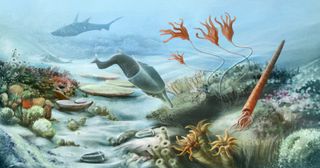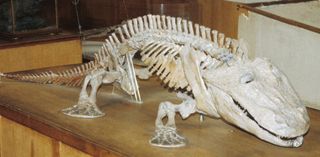Paleozoic Era: Facts & Information

The Paleozoic Era, which ran from 541 million to 251.9 million years ago, was a time of great change on Earth. The era began with the breakup of one supercontinent and the formation of another. Plants became widespread. And the first vertebrate animals colonized land.
Life in the Paleozoic
The Paleozoic began with the Cambrian Period, 53 million years best known for ushering in an explosion of life on Earth. This "Cambrian explosion" included the evolution of arthropods (ancestors of today's insects and crustaceans) and chordates (animals with rudimentary spinal cords).
In the Paleozoic Era, life flourished in the seas. After the Cambrian Period came the 45-million-year Ordovician Period, which is marked in the fossil record by an abundance of marine invertebrates. Perhaps the most famous of these invertebrates was the trilobite, an armored arthropod that scuttled around the seafloor for about 270 million years before going extinct.
After the Ordovician Period came the Silurian Period (443.8 million to 419.2 million years ago), which saw the spread of jawless fish throughout the seas. Mollusks and corals also thrived in the oceans, but the big news was what was happening on land: the first undisputed evidence of terrestrial life.
This was the time when plants evolved, though they most likely did not yet have leaves or the vascular tissue that allows modern plants to siphon up water and nutrients. Those developments would appear in the Devonian Period, the next geological period of the Paleozoic. Ferns appeared, as did the first trees. At the same time, the first vertebrates were colonizing the land. These vertebrates were called tetrapods, and they were widely diverse: Their appearance ranged from lizardlike to snakelike, and their size ranged from 4 inches (10 cm) long to 16 feet (5 meters) long, according to a study released in 2009 in the Journal of Anatomy.
As the tetrapods took over, they had company: The Devonian Period saw the rise of the first land-living arthropods, including the earliest ancestors of spiders.

Paleozoic evolution
Life continued its march in the late Paleozoic. The Carboniferous Period, which lasted from about 359 million years ago to 299 million years ago, answered the question, "Which came first — the chicken or the egg?" definitively. Long before birds evolved, tetrapods began laying eggs on land for the first time during this period, allowing them to break away from an amphibious lifestyle.
Trilobites were fading as fish became more diverse. The ancestors of conifers appeared, and dragonflies ruled the skies. Tetrapods were becoming more specialized, and two new groups of animals evolved. The first were marine reptiles, including lizards and snakes. The second were the archosaurs, which would give rise to crocodiles, dinosaurs and birds. Most creepily, this era is sometimes referred to as the "Age of the Cockroaches," because roaches' ancient ancestor (Archimylacris eggintoni) was found all across the globe during the Carboniferous.
The last period of the Paleozoic was the Permian Period, which began 298.9 million years ago and wrapped up 251.9 million years ago. This period would end with the largest mass extinction ever: the Permian extinction.
Before the Permian mass extinction, though, the warm seas teemed with life. Coral reefs flourished, providing shelter for fish and shelled creatures, such as nautiloids and ammonoids. Modern conifers and ginkgo trees evolved on land. Terrestrial vertebrates evolved to become herbivores, taking advantage of the new plant life that had colonized the land.
Paleozoic geology and climate
All this evolution took place against the backdrop of shifting continents and a changing climate. During the Cambrian Period of the Paleozoic, the continents underwent a change. They had been joined as one supercontinent, Rodinia, but during the Cambrian Period, Rodinia fragmented into Gondwana (consisting of what would eventually become the modern continents of the Southern Hemisphere) and smaller continents made up of bits and pieces of the land that would eventually make up today's northern continents.
The Cambrian was warm worldwide, but would be followed by an ice age in the Ordovician, which caused glaciers to form, sending sea levels downward. Gondwana moved further south during the Ordovician, while the smaller continents started to move closer together. In the Silurian Period, the land masses that would become North America, central and northern Europe, and western Europe moved even closer together. Sea levels rose again, creating shallow inland seas.
In the Devonian, the northern land masses continued merging, and they finally joined together into the supercontinent Euramerica. Gondwana still existed, but the rest of the planet was ocean. By the last period of the Paleozoic, the Permian, Euramerica and Gondwana became one, forming perhaps the most famous supercontinent of them all: Pangaea. The giant ocean surrounding Pangaea was called Panthalassa. Pangaea's interior was likely very dry, because its massive size prevented water-bearing rain clouds from penetrating far beyond the coasts.
Originally published on Live Science.
Sign up for the Live Science daily newsletter now
Get the world’s most fascinating discoveries delivered straight to your inbox.

Stephanie Pappas is a contributing writer for Live Science, covering topics ranging from geoscience to archaeology to the human brain and behavior. She was previously a senior writer for Live Science but is now a freelancer based in Denver, Colorado, and regularly contributes to Scientific American and The Monitor, the monthly magazine of the American Psychological Association. Stephanie received a bachelor's degree in psychology from the University of South Carolina and a graduate certificate in science communication from the University of California, Santa Cruz.
